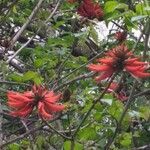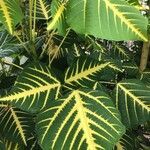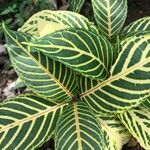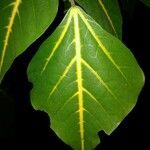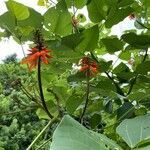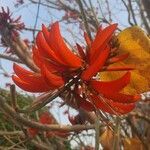Deciduous tree 4–25 m high; trunk, branches and branchlets spiny (scattered large conical prickles on trunk and branches, small black prickles on terminal branchlets, fide Bean (2008: 644)). Leaves, branchlets, inflorescence, calyx and pods stellate-tomentulose at first, ± glabrescent. Leaves compound with 3 leaflets; leaflets broadly ovate, oblate, oblate-ovate, oval, rhombic or triangular, acute to acuminate with sharp or obtuse tip, sometimes variegated, 4–20 cm long, 3–21 cm wide; petiole 4–14 (–24) cm long. Inflorescences racemose, lateral at apex, 10–40 cm long; flowers to 7.5 cm long, red to scarlet. Calyx spathaceous, 2–4 cm long (including 5 filiform lobes at apex). Standard narrowly elliptic, (4.5–) 5–7 (–7.5) cm long, 1.6–2.5 cm wide; wings and separate keel petals less than half length of standard. Stamens all united. Pods terete, submoniliform, 7–25 (–30) cm long, c. 1.5–2.8 cm diam., glabrous, prominently veined. Seeds obloid to obloid-elliptisoid, 13–22 mm long, 10–11 mm wide, 8.5–10 mm thick, reddish brown or wine-red to purple-brown. See Bean (2008: 644) for more detailed description. See Du Puy & Telford (1993: 216–217) for treatment of E. variegata occurring on Christmas and the Cocas (Keeling) Islands.
Trees, up to 20 m tall. Bark dark brown. Branches with obvious, black, straight and minute prickles; core pulpy. Leaves pinnately 3-foliolate, usually clustered at branch tip; stipules lanceolate, deciduous; petiole 10-15 cm, usually without prickles; leaflets broadly ovate or rhomboid-ovate, 15-30 × 15-30 cm, membranous, both surfaces glabrous, basal veins 3, lateral veins 5 pairs, base broadly cuneate or truncate, margin entire, apex acuminate to obtuse; base of leaflet with a pair of glands similar to stipules. Raceme terminal, 10-16 cm; peduncle robust, woody, 7-10 cm, pubescent; flowers paired. Calyx spathelike, 2-3 cm, mouth oblique, split on one side. Corolla red, 6-7 cm; standard elliptic, 5-6 × ca. 2.5 cm, apex obtuse, shortly clawed; wings and keels subequal; keel petals separate. Ovary micro-villous; style glabrous. Legume black, reniform, ca. 1.5 × 1 cm. Seeds puniceous, oblong or oblong-ellipsoid. Fl. Feb-May, fr. Apr-Aug. 2n = 42.
A deciduous tree. It grows up to 15-20 m tall and loses its leaves for part of the year. The trunk has blunt spines. The branches are spreading, crooked and armed with sharp black prickles. The leaves have 3 leaflets. The leaflets are broadly oval and 8 to 18 cm long. They are shiny green on top and dull flat green underneath. The flowers appear before the leaves. The flowers are at the ends of branches and are hairy and dense. The flowers are large numerous and hang down. They are red. The pod is about 10 to 25 cm long and 1.5 to 2 cm across. The pod is constricted between the beans. Seeds are dark red.
